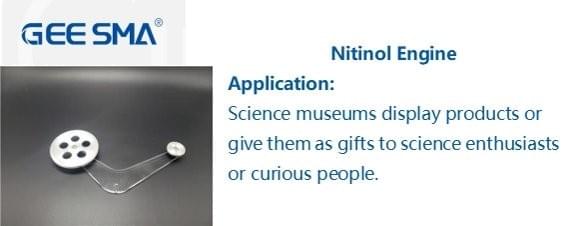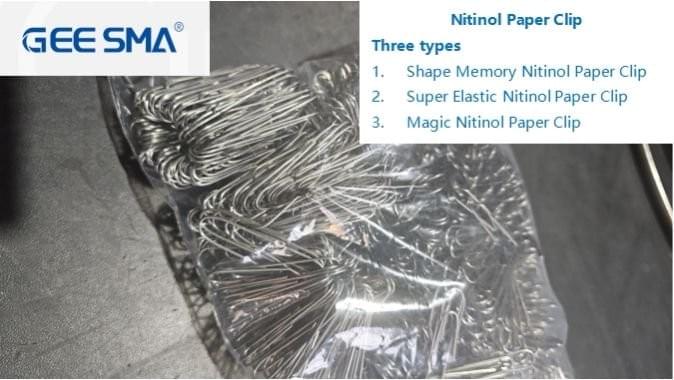Introduction
Nitinol, a remarkable alloy of nickel and titanium, stands out for its unique properties that have revolutionized various industries. Its ability to return to a predetermined shape upon heating makes it a prime candidate for applications involving SMA actuator wires. As we delve deeper into what makes Nitinol so special, we will explore the fascinating world of shape memory alloys and their myriad uses.
What Makes Nitinol So Special
What sets Nitinol apart from other materials is its extraordinary capability to undergo phase transformations between two distinct forms: martensite and austenite. This characteristic allows Nitinol to exhibit both superelasticity and the shape memory effect, making it an ideal choice for creating SMA actuator wires that can perform complex movements with precision. Whether it's in medical devices or robotics, Nitinol's versatility continues to astonish engineers and designers alike.
Understanding Shape Memory Alloys
At its core, an SMA wire is defined by its ability to remember a specific shape when subjected to temperature changes. When heated above a certain threshold, an SMA wire transforms from its deformed state back into its original configuration—this is the essence of what is an SMA wire? This unique feature not only enhances functionality but also opens avenues for innovative designs in various applications ranging from automotive components to aerospace technology.
The Applications of SMA Wire
The utility of SMA wires extends far beyond simple mechanical functions; they serve as critical components in numerous advanced technologies. From actuating mechanisms in robotics to enabling precise movements in aerospace systems, the applications are vast and varied. By harnessing the capabilities of these specialized wires, industries can achieve greater efficiency and performance while reducing overall system complexity through innovative use of what is an actuator wire?
What is an SMA Wire?

SMA wire, or Shape Memory Alloy wire, is a remarkable material that can remember its original shape after being deformed. This unique property makes it highly sought after in various industries. Understanding what an SMA wire is and how it functions opens the door to innovative applications, particularly in robotics and aerospace.
Definition and Characteristics
An SMA wire is a type of metal alloy that exhibits the shape memory effect, allowing it to return to its pre-deformed shape when exposed to a specific temperature. Nitinol, a nickel-titanium alloy, is one of the most widely used SMA wires due to its excellent mechanical properties and biocompatibility. The ability of these wires to undergo phase transformations under varying temperatures allows them to perform various tasks effectively, making them invaluable in engineering applications.
How it Works
The magic behind an SMA actuator wire lies in its unique crystalline structure that changes between two phases: martensite (the low-temperature phase) and austenite (the high-temperature phase). When the temperature rises above a certain threshold, the wire transforms from martensite back into its original shape (austenite), generating movement or force in the process. This transformation not only enables precise control but also allows for energy-efficient operation, making SMAs ideal for use in devices like actuators.
Common Uses in Industry
SMA wires are employed across numerous industries due to their versatility and efficiency. In robotics, they serve as actuators that enable movement without bulky motors or gears—making designs more compact and lightweight. Additionally, applications extend into medical devices such as stents and surgical tools where precise movements are essential; this highlights just how integral sma actuator wires are in modern technology solutions.
What is an Actuator Wire?

Actuator wires are specialized wires that utilize the unique properties of shape memory alloys (SMAs) to create motion or force in various applications. These wires change shape in response to temperature changes, effectively converting thermal energy into mechanical work. Among these, Nitinol is a prominent example of an SMA wire, known for its remarkable ability to return to a predetermined shape when heated.
Actuator Wire Explained
So, what is an actuator wire? Essentially, it’s a type of SMA actuator wire designed to respond dynamically to temperature variations. When heated above a specific transition temperature, the SMA wire contracts and can perform mechanical tasks such as pulling or lifting objects. This transformation occurs due to the unique crystalline structure of the material, which allows it to remember its original form.
Applications in Robotics and Aerospace
The applications of actuator wires extend far and wide, particularly in robotics and aerospace industries where precision and reliability are paramount. In robotics, SMA actuator wires enable movement in robotic arms and grippers with minimal power consumption while providing smooth operation. Meanwhile, in aerospace applications, these wires are utilized for deploying mechanisms like flaps or landing gear due to their lightweight nature and high strength-to-weight ratio.
Benefits of Using Actuator Wire
Using an actuator wire offers multiple benefits that make it a preferred choice for engineers across various fields. These wires are not only lightweight but also highly efficient; they require minimal energy input while delivering significant output force when activated. Additionally, the compact design of SMA actuators allows for innovative engineering solutions where space is at a premium—making them ideal for modern technological advancements.
What is an SMA Actuator?

SMA actuators are fascinating devices that utilize the unique properties of shape memory alloys (SMAs), particularly Nitinol, to create movement in response to thermal changes. These actuators operate based on the shape memory effect, allowing them to return to a predefined shape when heated after being deformed. This remarkable functionality makes SMA actuator wires particularly valuable in various applications where precise movement is essential.
Functionality of SMA Actuators
The functionality of SMA actuators hinges on their ability to undergo phase transformations between two distinct states: austenite and martensite. When an SMA actuator wire is heated beyond its transformation temperature, it transitions from the deformed martensitic state back to its original austenitic shape, generating motion in the process. This simple yet effective mechanism allows for compact designs that can produce significant force and displacement without complex components.
Moreover, the response time of an SMA actuator can be quite rapid, making it suitable for applications requiring quick movements or adjustments. The integration of SMA wires into systems allows for innovative designs that can save space and weight while maintaining high performance levels. As industries continue to demand more efficient solutions, understanding what an SMA actuator is becomes increasingly crucial.
Comparison with Traditional Actuators
When comparing SMA actuators with traditional actuators—like electric motors or hydraulic systems—a few key differences emerge that highlight their unique advantages. Traditional actuators often rely on external power sources and complex mechanical linkages, which can add bulk and limit design flexibility. In contrast, what is an actuator wire like those made from SMAs? They are lightweight and offer a simpler design without needing additional components for actuation.
Another notable difference lies in energy efficiency; SMA actuators convert thermal energy directly into mechanical work without requiring large amounts of electrical power or hydraulic fluid. This efficiency translates into lower operational costs over time and reduces environmental impact as well. Understanding these distinctions helps engineers appreciate why one might choose an SMA actuator over traditional options in specific applications.
Advantages in Engineering Applications
SMA actuators provide several advantages that make them appealing for engineering applications across various fields such as robotics, aerospace, and medical devices. One significant benefit is their ability to operate silently compared to traditional motor-driven systems—an important factor when noise reduction is critical in environments like hospitals or residential areas. Additionally, the compact nature of sma actuator wires allows engineers greater freedom in design choices without sacrificing performance.
Another advantage lies in their resilience; Nitinol's inherent properties allow these actuators to withstand harsh conditions including extreme temperatures and corrosive environments while maintaining functionality over extended periods. This durability makes them ideal candidates for aerospace missions where reliability is paramount under varying atmospheric conditions. Overall, the combination of compactness, efficiency, and robustness positions what is an SMA actuator at the forefront of modern engineering solutions.
Exploring Shape Memory Actuators

Shape memory actuators are fascinating devices that leverage the unique properties of shape memory alloys (SMAs) to create movement in response to temperature changes. In particular, Nitinol, a popular SMA wire, is known for its remarkable ability to return to a predetermined shape when heated. This capability makes SMA actuator wires incredibly versatile in various engineering applications.
Mechanism Behind Shape Memory Effect
The mechanism behind the shape memory effect is rooted in the unique crystalline structure of SMA materials like Nitinol. When an SMA wire is deformed at lower temperatures, it retains this new shape until it is heated above a certain transition temperature, at which point it remembers its original form and returns to it. This transformation occurs due to a phase change within the material's crystal lattice, allowing for precise control of movement and force generation in applications such as robotics and aerospace.
Understanding what an SMA actuator is requires recognizing how this mechanism translates into practical use. When you apply heat to an SMA actuator wire, it contracts or expands depending on its configuration and the external conditions, enabling mechanical motion that can be harnessed for various tasks. The ability to activate motion with just a change in temperature makes these actuators highly efficient compared to traditional systems.
Material Properties of Nitinol
Nitinol boasts several exceptional material properties that make it ideal for use in shape memory actuators. First and foremost, its high fatigue resistance ensures longevity and reliability even after repeated cycles of deformation and recovery—something critical for demanding applications like robotics or prosthetics. Additionally, Nitinol exhibits excellent corrosion resistance, making it suitable for environments where exposure to moisture or harsh chemicals might be a concern.
Another important property of Nitinol is its ability to undergo significant strain while maintaining structural integrity; this means that an SMA actuator wire can bend or twist without breaking under stress. Furthermore, the specific transition temperatures can be tailored during manufacturing processes, allowing engineers to customize performance characteristics based on their project needs—an essential aspect when considering what an actuator wire can do across different industries.
Real World Applications
The real-world applications of shape memory actuators are as diverse as they are impressive. In robotics, these actuators provide lightweight yet powerful solutions for creating movements that mimic natural muscle contractions—ideal for soft robotics designs where flexibility is key. Similarly, in aerospace engineering, SMA actuator wires enable precise control mechanisms such as deployable wings or landing gear systems that need reliable performance under varying thermal conditions.
Medical devices also benefit from the unique capabilities of SMAs; think about stents or guidewires that expand or contract based on body temperature—this innovation has revolutionized minimally invasive surgical techniques! Additionally, automotive industries leverage these materials for active suspension systems that adapt dynamically based on driving conditions—a perfect example of how understanding what an SMA actuator entails can lead to groundbreaking advancements across multiple sectors.
GEE SMA: A Leader in Nitinol Production

GEE SMA has established itself as a pioneer in the production of Nitinol, a remarkable shape memory alloy that has gained significant traction across various industries. With a commitment to innovation and excellence, GEE SMA focuses on developing cutting-edge solutions that leverage the unique properties of SMA wires and actuators. Their mission is to provide high-quality products that meet the evolving needs of engineers and manufacturers worldwide.
Company Overview and Mission
Founded with a vision to revolutionize the field of materials science, GEE SMA specializes in shape memory alloys (SMAs), particularly Nitinol. The company prides itself on its rigorous research and development processes, ensuring that their sma actuator wire products are at the forefront of technology. GEE SMA's mission revolves around enhancing performance in engineering applications while maintaining sustainability and efficiency.
Innovations in Shape Memory Alloys
GEE SMA continuously pushes the boundaries of what is possible with shape memory alloys, making significant strides in the design and manufacturing of sma actuator wire. By integrating advanced techniques such as precise thermal treatment and innovative alloy compositions, they have developed SMAs that exhibit superior performance characteristics. These innovations not only enhance the functionality of what is an actuator wire but also expand its potential applications across various sectors.
Impact on Aerospace Missions
The contributions of GEE SMA to aerospace missions are nothing short of transformative, particularly through their state-of-the-art sma actuator wire solutions. By providing lightweight yet robust components that can withstand extreme conditions, these shape memory actuators play a crucial role in improving aircraft efficiency and safety. As aerospace technology continues to advance, GEE SMA remains committed to supporting this progress by delivering reliable products that meet stringent industry standards.
Conclusion
As we wrap up our exploration of shape memory alloys (SMAs) and the fascinating world of Nitinol, it’s clear that the future of SMA technology is brimming with potential. The versatility and unique properties of SMA actuator wire open doors to innovative applications across various industries, from robotics to aerospace. With ongoing research and development, we can expect even more groundbreaking advancements that will redefine engineering possibilities.
The Future of SMA Technology
The future of SMA technology looks promising as engineers and scientists continue to unlock its capabilities. As more industries recognize the advantages of using an SMA actuator wire, we can anticipate a surge in demand for these remarkable materials. Innovations in processing techniques and material design will likely lead to even more efficient and reliable shape memory actuators that push the boundaries of what’s possible.
Nitinol's Role in Modern Engineering
Nitinol has established itself as a cornerstone in modern engineering due to its unique properties, including superelasticity and shape memory effect. What is an SMA wire? It's not just a simple metal; it's a game-changer that allows for dynamic movement in applications ranging from medical devices to robotic systems. As engineers increasingly turn to Nitinol, its role will only grow, driving forward technological advancements.
Why Choose GEE SMA for Your Needs
When selecting a supplier for your SMA actuator wire needs, GEE SMA stands out with its commitment to innovation and quality. What is an actuator wire if not a vital component crafted with precision? GEE SMA not only produces high-quality materials but also invests in research that enhances the capabilities of shape memory actuators, ensuring you receive top-tier products tailored to your specific requirements.

